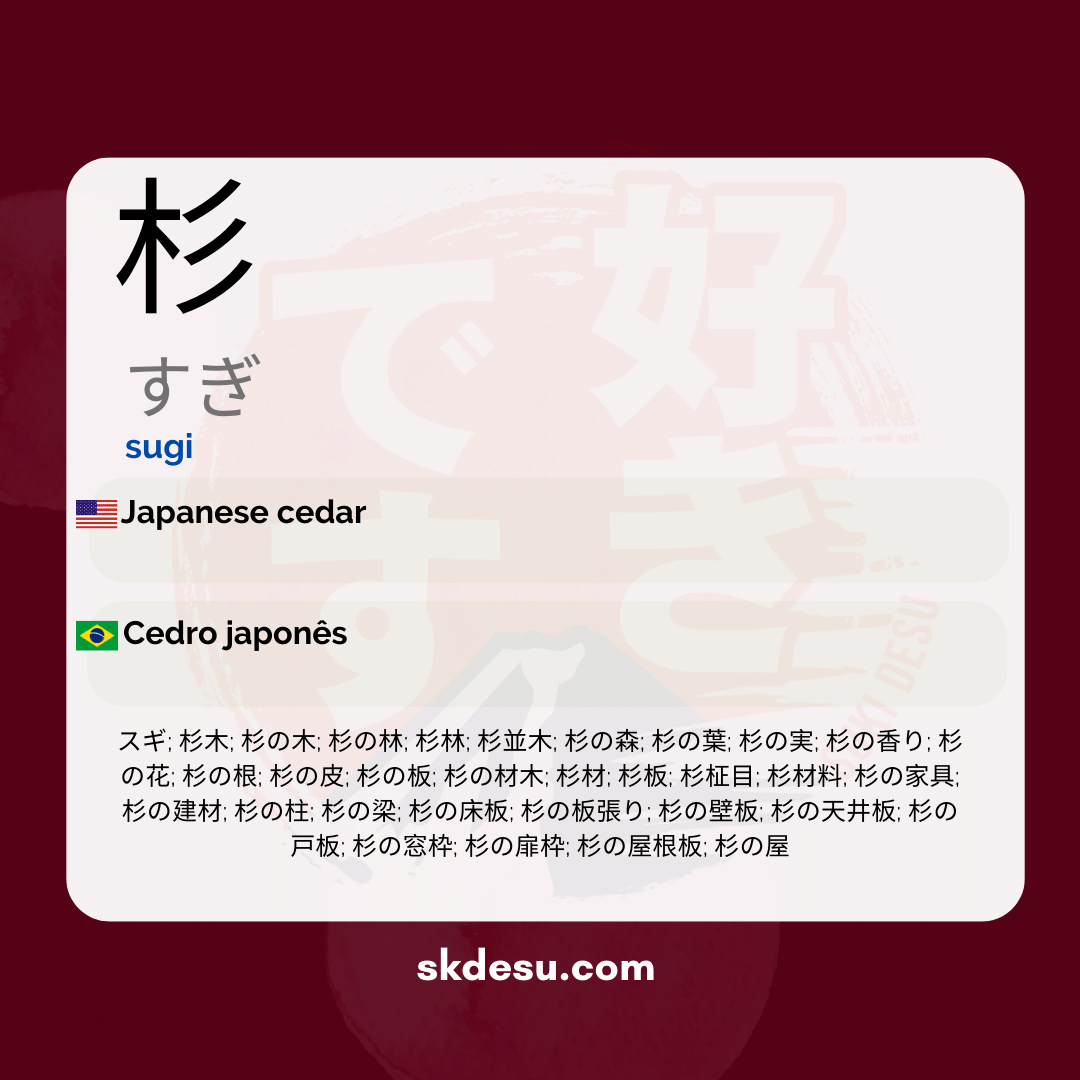Translation and Meaning of: 杉 - sugi
The Japanese word 杉[すぎ] may seem simple at first glance, but it carries deep meanings and cultural connections that are worth exploring. If you are studying Japanese or just curious about the language, understanding terms like this can open doors to a richer understanding of the language and Japanese culture. In this article, we will dive into the meaning, origin, and practical uses of すぎ, as well as discover how it appears in everyday life and media in Japan.
Meaning and origin of 杉[すぎ]
杉[すぎ] is the Japanese word for "cedar," specifically Japanese cedar (Cryptomeria japonica), a tree native to Japan known for its high-quality wood. The kanji 杉 is composed of the radical 木 (tree) combined with 彡, which represents patterns or lines, possibly referring to the texture of the bark or the vertical growth of the tree. This etymology reflects the close relationship between the Japanese language and nature.
The Japanese cedar has great historical importance in the country, being widely used in the construction of temples, traditional houses, and even in works of art. Its presence in culture is so significant that it often appears in haikus and literature as a symbol of resilience and longevity. Learning this word goes beyond vocabulary – it is a window to understand part of Japanese identity.
Everyday and cultural use of すぎ
In daily life, すぎ is used both to refer to the tree itself and to products made from its wood. Phrases like "この家は杉でできている" (This house is made of cedar) are common in contexts involving architecture or craftsmanship. It is worth noting that, unlike some words for trees, すぎ is rarely used metaphorically in idiomatic expressions, remaining more closely linked to its literal meaning.
Culturally, the Japanese cedar holds a special status in certain regions. In Nara, for example, it is believed that the large cedars around the Kasuga Shrine have protective spirits. This tree also frequently appears in animes and dramas that depict rural life or historical themes, serving as a backdrop for scenes in traditional villages.
Tips for memorization and curiosities
An effective way to memorize すぎ is to associate the kanji 杉 with the image of a tree with vertical lines on its bark – just what the component 彡 suggests. Students often find it easier to remember this kanji when they perceive this visual connection. Another tip is to recall that すぎ sounds like "sugi", which can be associated with the sound of the wind passing through cedar leaves.
A verified curiosity is that the Japanese cedar is the official tree of several prefectures, including Nara and Yamanashi. Additionally, research from the Ministry of Agriculture of Japan shows that すぎ is among the 10 most used words for trees in school manuals, highlighting its relevance in basic education. For those looking to expand their vocabulary, learning related terms such as 杉材 (cedar wood) or 杉林 (cedar forest) can be a good next step.
Vocabulary
Expand your vocabulary with related words:
Synonyms and similar words
- スギ (Sugi) - A type of Japanese conifer tree.
- 杉木 (Suginoki) - Cedar tree (that is, the same as スギ).
- 杉の木 (Sugi no ki) - Cedar tree.
- 杉の林 (Sugi no hayashi) - Cedar forest.
- 杉林 (Sugibayashi) - Cedar forest area.
- 杉の森 (Sugi no mori) - Cedar forest.
- 杉の葉 (Sugi no ha) - Cedar leaves.
- 杉の実 (Sugi no mi) - Cedar fruits.
- 杉の香り (Sugi no kaori) - Cedar perfume.
- 杉の花 (Sugi no hana) - Cedar flowers.
- 杉の根 (Sugi no ne) - Cedar roots.
- 杉の皮 (Sugi no kawa) - Cedar bark.
- 杉の板 (Sugi no ita) - Cedar board.
- 杉の材木 (Sugi no zaimoku) - Cedar wood.
- 杉材 (Sugizai) - Cedar material.
- 杉板 (Sugi ita) - Cedar board.
- 杉の家具 (Sugi no kagu) - Cedar furniture.
- 杉の建材 (Sugi no kenzai) - Cedar construction materials.
- 杉の柱 (Sugi no hashira) - Cedar column.
- 杉の梁 (Sugi no hari) - Cedar beam.
- 杉の床板 (Sugi no yaka ita) - Cedar floorboard.
- 杉の板張り (Sugi no ita bari) - Cedar wood cladding.
- 杉の壁板 (Sugi no kabe ita) - Cedar wall panel.
- 杉の天井板 (Sugi no tenjō ita) - Cedar ceiling board.
- 杉の戸板 (Sugi no to ita) - Cedar door panel.
- 杉の窓枠 (Sugi no madowaku) - Cedar window frame.
- 杉の扉枠 (Sugi no tobira waku) - Cedar door frame.
- 杉の屋根板 (Sugi no yane ita) - Cedar roof board.
Related words
Romaji: sugi
Kana: すぎ
Type: noun
L: jlpt-n2
Translation / Meaning: japanese cedar
Meaning in English: Japanese cedar
Definition: A coniferous tree from the cypress family.
Quick Access
- Vocabulary
- Writing
- Sentences
How to Write in Japanese - (杉) sugi
See below a step-by-step guide on how to write the word by hand in Japanese. (杉) sugi:
Example Sentences - (杉) sugi
See below some example sentences:
Sugi no ki wa utsukushii desu
The cedar tree is beautiful.
The Sugi trees are beautiful.
- 杉の木 - suginoki (Japanese cedar tree)
- は - wa (topic particle)
- 美しい - utsukushii (bonito)
- です - be (verb to be in polite form)
Other Words of this Type: noun
See other words from our dictionary that are also: noun

